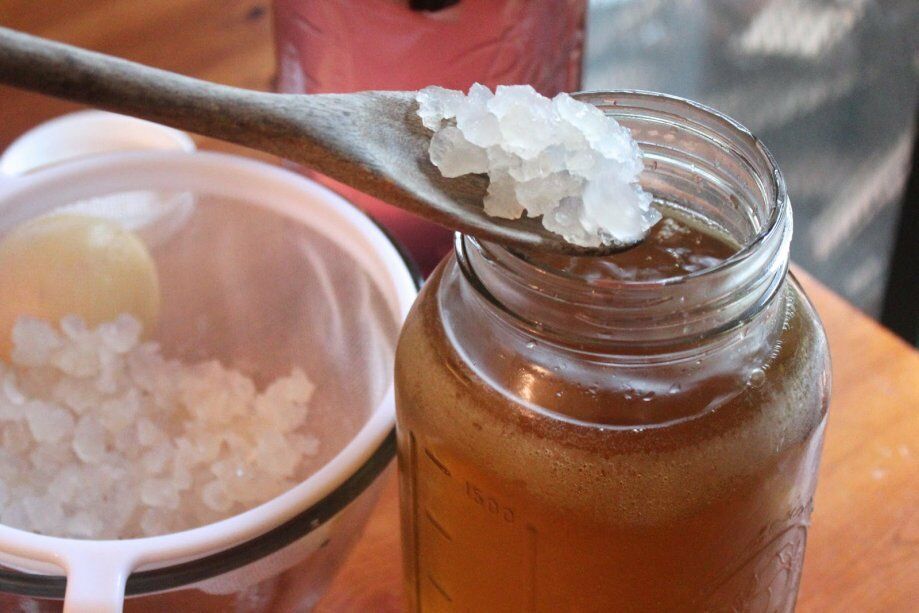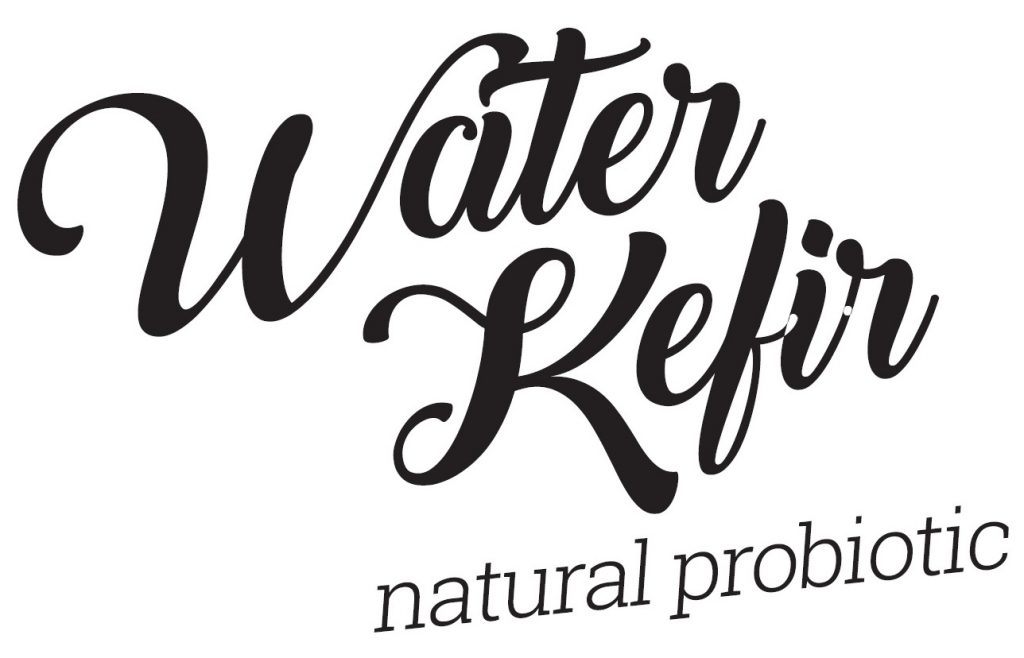Water kefir grains is a polysaccharide matrix that grows in a sugary water and makes a carbonated beverage .
Water kefir is made from kefir grains, also known as sugar grains, tibicos, tibi, or Japanese water crystals. The grains make up a culture of a combination of various strains of healthy bacteria and yeast, held together in a polysaccharide matrix created by the bacteria. These microbes present in the water kefir kefir act in symbiosis to maintain a stable culture. This symbiotic relationship of the microbes that feeds on sugar and produce lactic acid, alcohol (ethanol) and carbon dioxide, yielding a fermented carbonated beverage. The alcohol content is usually very minimal) less than 1 %.
Read more about water kefir grains, its origin and preparation on Wikipedia.

The basic preparation method is to add water kefir grains to a sugary liquid and allow it to ferment 24 to 48 hours. A typical recipe might contain the kefir grains, a citrus fruit and water. It is important that do not use ingredients that will inhibit the fermentation, such as chlorine in tap water or preservatives in dried fruit (sulfites). The fruits used may be changed and mixed to create different flavours. Additional precautions should be taken to keep the cultures healthy. The use of reactive metals such as aluminium, copper, or zinc should be minimised, since the acidity of the solution can draw these metals out, damaging the culture. The beverage should not be stored in metal containers, as these may leach into it over time. Instead, use stainless steel, plastic, non-lead-glazed ceramic or glass containers. Culturing grains in a glass jar and using clean stainless steel or plastic utensils when handling the grains is recommended.
Consuming water kefir drink has many benefits. Water kefir is rich in probiotics and contains a good mix of beneficial bacteria and yeast. Read more about this on HealthLine. Also it is dairy-free and vegan-friendly.
Usefull hints & tips
Do not let them starve for too long
If you order your grains by post, please feed and begin your brew the same day your grains arrive.
Please make sure you rinse the grains in spring water when you first receive them, as they will have been in post for 1-2 days. Also, make sure that you will place them in sugary water as soon as possible they are a living organism and they need food! They might take a few days to get going after they have been in the post, especially if bought in the winter.
Use Non-Metal
It is best practice and we recommend that you only allow your Water Kefir Grains To come into contact with non-metal (plastic, wooden, silicon, glass etc) containers, utensils and strainers.
Ideal Condition for Water Kefir Grains
Keep the jar somewhere out of direct sunlight. Around 20 degrees C (70 F) is ideal. Your Tibicos will ferment slower if it’s cooler and faster if it’s warmer. It can take at least a couple of bathes for your new grains to settle in and get up to full fermenting strength.
Fermentation Time
Around 24 hours will give a sweeter kefir, 48 hours gives a sourer version. Try the kefir after 24 hours to check the taste. Let it go for longer until you get your desired flavour. It is best not to ferment for longer than 72 hours unless you want to make vinegar. Over time, the Tibicos use up all the sugar and produce lactic acid.
Grain Behaviour

You can tell your Kefir Grains are active when you see bubbles appear on the surface of water. This is carbon dioxide being released by the grains as it breaks down the sugar. Most of the grains will be at the bottom of the jar, but you may also notice some float to the top. This is normal and happens due to small amounts of gas being trapped to the bottom of the jar. You will notice the grains floating up and down throughout the fermentation process. If your grains are in the ideal condition (water condition, type of sugar, temperature), you may find that they grow, and there is a little more after each batch. You may need to increase the amount of sugar and water you add to successive batches depending how many grains there are.
Do not worry if your grains do not seem to be growing, as long as they are staying the same size and still fermenting, you can keep using indefinitely. If there seem to be less grain after each batch, or they are not fermenting well, try switching the type of sugar or water you are using.
Getting Cheffy
There are a lot of recipes for kefir that add things like a slice of lemon, ginger or dried fruits to the first fermentation but water and sugar is all you need to make Water Kefir. If you do decide to add citrus fruits ( lemon, lime) it is recommended to add a slice and not juice as the juice will raise the acid levels quite quickly. Again, use your discretion. It is your Kefir, so go ahead, experiment!
Store Some Grains
Some experiments may not go to plan and not to be ideal condition for your Kefir grains and they can weaken or die. So make sure you keep a “just in case” store of them. Your grains can be stored in the fridge in a little of water and sugar, for months. Just top them up with some sugar and change the water every now and again. Keep them fed, keep them alive.
Water Kefir – How to Brew
Please keep in mind if you are new to water kefir it may take several batches before your grains become accustomed to your home and make consistent water kefir. The first batch of water kefir that you brew might not have so much activity. This is completely normal and due to the shock of travel, it may take them time to begin growing. Our biggest recommendation is to find a good supply of mineral rich water which will help your grains function and properly metabolize the sugars. Making water kefir is not an exact science and it is best to experiment to see what works best for you. Water kefir grains function best on a combination of white sugar and dried fruits, or a combination of white sugar and less processed sugar (whole cane, brown, molasses, etc). Three parts refined sugar to one part unrefined sugar is a good ratio to start with. If you add dried fruits, such as apricots or raisins, make sure they are unsulphured. A handful per quart is all you will need.
Notes: Never use tap water because it contains chemicals such as chlorine and fluoride. They will harm your grains over time. Most water filters will not effectively remove fluoride or other impurities. Do not let your grains come in contact with metal, prolonged exposure will harm them. Always use glass, plastic or wood when handling your grains to keep them safe.
How to Make Water Kefir Beverages
I am going to introduce different recipes for making water kefir grain beverages. They are very similar and you can use the one that suits your need or what works best for you:
Instructions – Water Kefir Grains Recipe 1
In a glass jar, dissolve one tablespoons of unrefined cane sugar and half. tablespoons of unrefined sugar with molasses. Add 400ml of room temperature mineral water (Evian tested and recommended). To that prepared liquid add 40g Water Kefir Grains when the water/sugar mixture is at room temperature.
Cover tightly with breathable lid for 24-48 hours with kitchen towel or cloth (do not seal them in a kilner jar or you may have a sticky explosion).
Keep the brew at room temperature, around 20 – 25 C.
After 24-48 hours (sooner will be sweeter) the resulting beverage will be lighter and less sweet. Then remove grains and strain the brew with a nylon sieve, and add new prepared water with sugar and molasses for next beverage.
You can drink the bevarage immediately or bottle into bottles for next 24-48 hours with your favourite fruits (ginger, lemon, raspberry, mango, etc.) to flavour. Also you can bottle into pressure proof bottles and leave sealed at room temperature for 1 day for extra fizziness ( be careful can explode).
If you fancy a break, put the grains in the sugar solution into the fridge, change water every 1-2 weeks and drink it.
Water Kefir Grains Recipe 2
Ingredients:
- 2 table spoons of grains (35g)
- 2 cups (500ml) spring/ mineral water
- 2-4 tablespoons (30-60g) of organic unrefined cane sugar (possible to use palm sugar, coconut sugar, rapadura sugar or jaggery) — use higher amount of sugar if you have a sweet tooth.
- Large clean jar with a lid (1-2 litres)
- Plastic sieve
- Wooden spoon
- Suitable container with wide-open mouth for straining kefir into (plastic or glass jug recommended)
- Clean sealable bottle to store kefir
Method of Preparation
- Dissolve sugar in small amount of hot water.
- When the sugar is dissolved add the rest of cold mineral water.
- Make sure the water is at the room temperature (22 C).
- Add the water kefir grains and cover the top of the jar with sterile cloth.
- Leave at room temperature in the dark place for 24-72 hours, the longer you leave it the more of the sugar ferments out. Do not leave it for too long as it can starve the grains if there is no sugar left.
- When it is fermented to your liking, strain the mixture through the sieve into suitable container, retaining the grains in the sieve.
- Wash the fermenting jar and reuse the kefir grains by repeating the whole process. It is better to start with a small amount in case you do not like it, it does not agree with you, or some people may have an allergy to it. If you having the kefir for the first time go for a half of a small glass on your first day and gradually increase intake on daily basics (just to make sure you will not have to run to the loo too often).
Water Kefir Grains Recipe 3
Basic Water Kefir Formula:
- 3 glasses mineral rich water
- 4 tablespoons sugar
- 4 tablespoons water kefir grains (as supplied)
Combine the water and sugar and stir until the sugars are completely dissolved. Pour the sugar solution into a quart size jar or container. Gently place the grains into the sugar solution. You can add any fruits now. Cover with a non-air tight lid (to avoid possible, but unlikely explosion as the carbon dioxide builds up) and allow to brew between 650 — 820F (180 — 280C) for 24 to 72 hours. Cheesecloth works great as a breathable cover. Place the water kefir mixture on a counter away from direct sunlight. When the water kefir is done brewing, simply strain the grains out and enjoy the beverage. There is no need to rinse your grains in-between batches. If you are using filtered or distilled water, you will need to add minerals.
A small pinch of Himalayan or Celtic salt can help. A small pinch (around 1/8 teaspoon) of baking soda or calcium carbonate will help promote growth. A basic recipe using 4 tablespoons of white sugar and 1 teaspoon to a tablespoon of blackstrap molasses will help if you are having difficulties getting your grains active.
You may use other minerals such as a pinch of bicarbonate or salt, eggshell (calcium) and perhaps lemon or ginger. It is not recommended to use only white sugar as it does not have malt. Be careful with dried fruits, they may contain preservatives (sulfur dioxide) that may stop fermentation.
To get your final water kefir carbonated, you will need to bottle it in an airtight container, jar or bottle for about 2 to 5 days at room temperature.
Water Kefir Grains Recipe 4
How to Care For & Grow Your Probiotic Grains
You’ll need:
- a non metallic container (suitable for liquids)
- a wooden or plastic spoon
- a non metallic filter or fine sieve
- mineral water
- unrefined sugar
Do’s &Don’ts!
Do keep your fermenting liquid/culture mix somewhere warm (at room temperature).
Do not seal the lid due to the resulting carbonation and pressure builds up.
Do use only wooden, glass or plastic utensils, sieves/filter or containers etc.
Do not let your grains come into contact with any metal utensils, filters etc.
Do use good mineral water – the grains depend on the additional minerals.
Do not use tap water due to the chorine added to it.
Do use unrefined cane sugar or mix 50/50 with white sugar.
Do not use raw honey.
** Do be aware of the fluctuating alcohol content! **
Do not drink if you need to avoid alcohol due to driving, pregnancy
How to Grow Your Grains
Use a non-metallic container appropriate for liquids to grow your grains in. Find a warm place for it as fermentation takes place. Remember not to seal the lid as the grains produce carbon dioxide as they ferment – you do not want a build up of pressure as this could lead to a sticky mess. It might take up to 72 hours for your grains to start fermenting after delivery.
As the grains grow, they absorb and convert the sugars to alcohol. The average alcohol content created by the fermentation process is generally quite low, but can increase due to several factors – higher sugar levels, warmer environment and longer fermentation time
Fermentation times of 72 hours, which will lead to your grains breaking down.
For a quicker start up of fermentation and growth of your grains, make sure your both your mineral water and grains are at room temperature.
- Pour 1 litre of mineral water into container
- Add approx 200g of unrefined sugar or a 50/50 mix with white sugar
- Stir with a wooden/non metallic spoon
- Add water kefir grains, stir gently, and cover
- Allow to ferment for 48hrs (this should start within 12hrs in a warm room)
- Strain and enjoy your naturally carbonated, probiotic drink as is, or add fruit
The filtered, carbonated drink will continue to absorb some sugar so the sweetness may diminish, leaving a ‘drier’ flavour. Your probiotic solution is best if consumed within 72 hours.
Dried Water Kefir Grains
Dried water kefir grains are grains that have become dormant after being dried and dehydrated. Dried water kefir grains can take several batches before becoming fully active and able to grow (The kefir that is produced is considered drinkable after a couple of brews). Dried grains can travel further distances with less risk. If you are ordering to international destinations then please order these grains. You can also store these grains if you are not ready to use them right away.
The other advantage of dried grains is that you can keep them in the fridge or freezer for several months before you activate them.
The disadvantage of these dried grains is that it takes longer to activate them than live grains.
Please note that rehydration (activation) requires time and patience.
INSTRUCTIONS FOR ACTIVATING DRIED WATER KEFIR GRAINS

- Heat about 4 cups of water (1 litre)
- Pour into glass jar.
- Dissolve 100-120g sugar in the water.
- Cool to 20°-25°C.
- Empty entire packet of dehydrated water kefir grains into cooled sugar water.
- Cover with a coffee filter or cloth, secured by a rubber band.
- Place in a warm spot, 20°-25°C, for 3-4 days.
- After 4 days grains should be plump and translucent. They are now ready to make water kefir. Strain the sugar water off and discard it.
After the 4th day you can use the description below to make water kefir beverage (or you can use one of the recipes mentioned earlier)
INSTRUCTIONS FOR MAKING WATER KEFIR
- Pour 100g-120g sugar in to the jar.
- Add 100-120ml hot water.
- Swirl to dissolve the sugar.
- Add 3-4 cups (max. 1 litre) room temperature or cool water.
- Check the temperature of the liquid to make sure it’s room temperature (20°-25°C)
- Add the water kefir grains
- Cover the jar and place in a warm spot, 20°-25°C, to culture for 24-48 hours.
- After culturing is complete, prepare a new batch of sugar water, (steps 1-4 above).
- Separate kefir grains from the finished water kefir.
- Place kefir grains in the new batch of sugar water.
- The finished drink is now ready to consume, flavour, bottle, or store in the fridge
Have fun!
See also: Milk Kefir Grains vs. Powdered Kefir Starter Culture & Bottled Kefir
See also: Tibetan Mushroom Kefir: Preparation And Benefits
Facebook Comments
